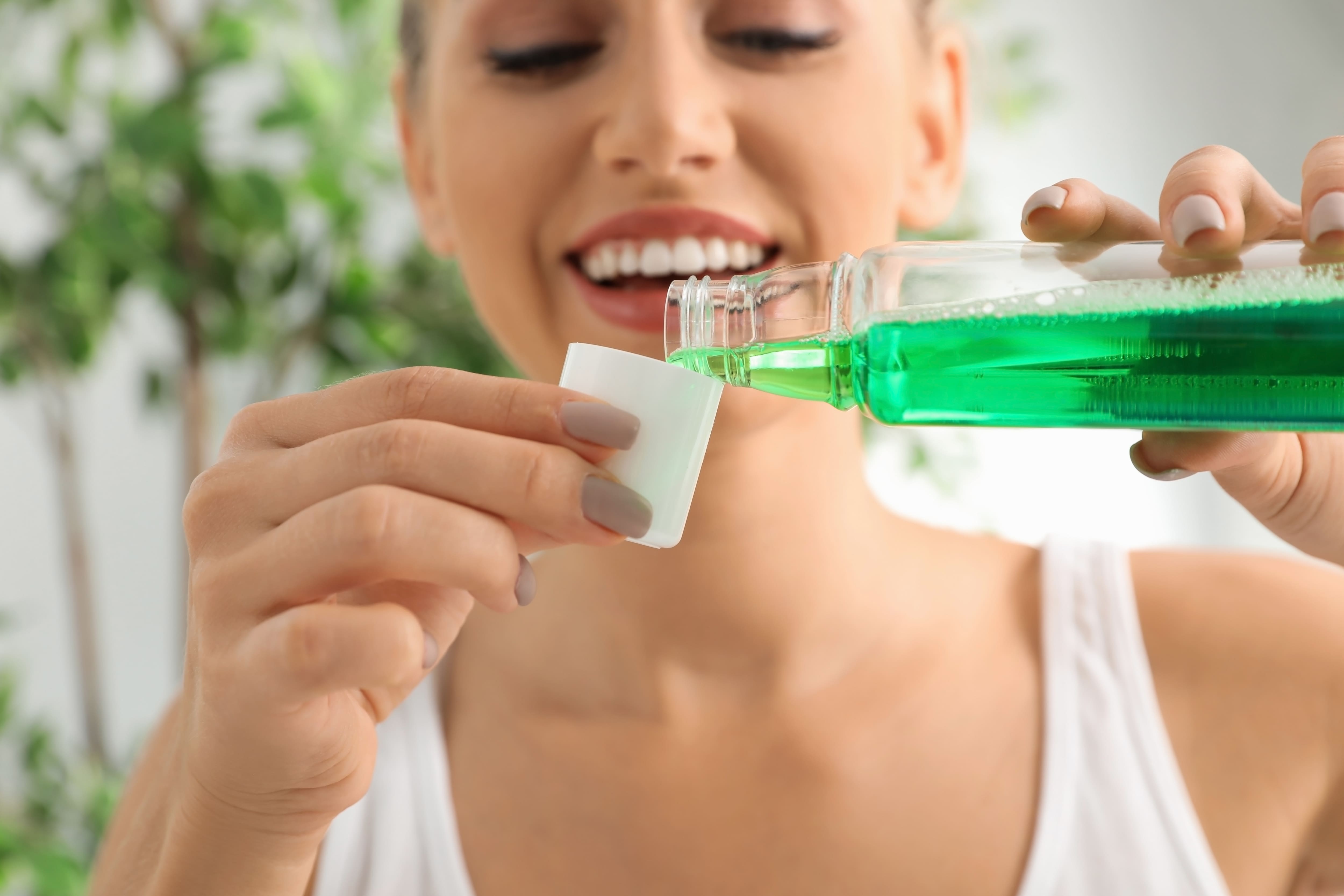Gum disease results from bacteria that builds up in your mouth, turning into plaque and then tartar. So it's important to use oral care tactics that remove bacteria before they make a permanent home for themselves in your mouth. Using mouthrinse (sometimes referred to as therapeutic mouthwash) for gum disease can help you win this battle and maintain a healthy and pain-free smile!
Signs You Have Gum Disease
When plaque is not thoroughly removed from your teeth and from around your gums, plaque bacteria can irritate and inflame the gum tissue. At this point, you may start to notice the early signs of gum disease, or gingivitis, such as:
- Red, swollen, and tender gums.
- Bleeding when brushing or flossing.
- Bad breath.
As plaque continues to build up, gingivitis can turn into an advanced form of gum disease called periodontitis. At this point, the gums start to pull away from the teeth, creating pockets below the gum line where bacteria and food become trapped. As the inflammation spreads, the bones and other tissues that hold your teeth in place start to break down, leading to symptoms like:
- Sensitive teeth.
- Longer-looking teeth.
- Shrinking or receding gums.
- Loose teeth.
- Shifting teeth.
- A misaligned bite (how your top and bottom teeth fit together)
- Pain when chewing.
If you're experiencing any of these symptoms, it's time to call your dental professional and bring out the dental artillery! Gingivitis is reversible, but the damage done by periodontitis is not. The sooner you fight signs of gum disease, the greater your chance of reversing it.
How Does Mouthwash Work?
There are two types of mouthwash: cosmetic and therapeutic. A cosmetic mouthwash is used purely to freshen the breath. A therapeutic mouthwash, on the other hand, contains one or more ingredients that offer a specific oral health benefit. For example, a therapeutic mouthwash might contain fluoride to protect against cavities, or antibacterial agents to reduce plaque.
Both cosmetic and therapeutic mouthwashes are used in the same way: by swishing the liquid around your mouth and then spitting it out. You can buy cosmetic mouthwashes and some therapeutic mouthwashes over the counter, but some therapeutic mouthwashes are prescription-only.
How Mouthwash Can Help Gum Disease
A therapeutic mouthwash could be helpful for preventing or managing gum disease. For example, an over-the-counter antimicrobial mouthrinse can kill 99 percent of germs on contact and provide several hours of protection against germs, even after you've eaten a meal or had a drink. Because it kills the bacteria responsible for gingivitis and bad breath simultaneously, an antimicrobial mouthrinse is an excellent add-on to your regular oral hygiene routine to keep your breath fresh and your gums healthy.
It’s important to note that if you have advanced gum disease (periodontitis), a mouthwash alone will not be sufficient; you’ll need professional help, so schedule an appointment with your dental professional to discuss your options.
How to Choose a Mouthwash for Gum Disease
When shopping for an antimicrobial mouthrinse, the American Dental Association (ADA) recommends that you look for a product with the ADA Seal of Acceptance. Your dentist and dental hygienist will always recommend that you choose a product with the ADA Seal, as these products have gone through rigorous scientific tests to confirm that they are safe and they do what they claim to do.
To find the best mouthwash for the job, look for one with antimicrobial ingredients that kill bacteria and reduce plaque. To avoid irritating tender gums, also look for a formula that contains no alcohol.
Top 3 Best Mouthwashes for Gum Disease
Looking for a recommendation on the best mouthwash for gum disease? Colgate has you covered! Here are our three top picks, depending on your unique oral health needs.
Best for everyday use: Colgate® Total® Mouthwash for Gum Health
For everyday gum protection, this antiseptic mouthwash offers advanced protection for stronger, healthier gums.
- Contains cetylpyridinium chloride, an anti-plaque ingredient that kills bacteria and prevents the build-up of tartar and plaque.
- Protects against bacteria for 12 hours after use.
- Reduces gingival bleeding.
- Alcohol-free.
Best for tender gums: Colgate® Peroxyl® Mouth Sore Rinse
For tender mouths, this gentle mouthwash contains hydrogen peroxide to cleanse and promote the healing of irritated oral tissues.
- Removes oral debris with a gentle, bubbling action.
- Reduces gum inflammation from dental procedures, dentures and orthodontic appliances.
- Kills bacteria.
- Alcohol-free.
Best for braces: Colgate® Ortho Defense® Phos-Flur Mint
It can be difficult to keep plaque under control while wearing braces or other orthodontic appliances, leaving you at increased risk of gum disease and cavities. This orthodontist-recommended mouthwash is formulated to give you extra support so you can unveil your healthiest, brightest smile.
- Protects against gingivitis.
- Strengthens enamel.
- Prevents decay and cavities.
- Alcohol-free.
Mouthrinse to Treat Periodontal Disease
Perhaps your gingivitis is getting worse and has advanced to periodontal disease. Or maybe your gingivitis hasn't progressed, but it's still not going away after committing to a vigorous at-home oral care routine. If your dentist is treating you for gum disease that has yet to subside, they will probably advise you to use a prescription-strength mouthrinse as a part of your treatment regimen.
A prescription-strength mouthrinse treats gingivitis by attacking germs to reduce inflammation, bleeding gums, and plaque formation. A mouthrinse is a safe and effective product, but you need to follow your dental professional's instructions for use as you would with any drug. Let your dental professional know if you have any sensitivity or adverse side effects while using a prescription-strength mouthrinse.
Other Tools to Fight Gum Disease
When it comes to fighting gum disease, don't forget the basics!
Brushing your teeth twice a day promotes a healthy and confident smile. It's your primary defense to clean plaque (biofilm) from your teeth and gums. And the daily use of an interdental cleaner, such as floss or a water flosser, is necessary to remove plaque from between your teeth, too. Also, be sure to replace your toothbrush every three months. Frayed bristles don't clean well, and old brushes can harbor bacteria.
Remember, once plaque hardens into tartar, you can't remove it with your at-home oral care routine. Regular, professional cleanings at your dental professional's office will remove the plaque and hardened tartar that forms on your teeth before it has a chance to cause gum disease. A professional cleaning can also help reverse gingivitis in its early stages. If you tend to build up a fair amount of tartar between your regular professional cleanings, your dental professional may recommend a tartar control toothpaste and more frequent cleanings.
Antimicrobial mouthrinse is a great tool to have in your arsenal for keeping your gums healthy. But to be effective, you should use a mouthrinse for gum disease in conjunction with your other tried-and-true hygiene tools. We recommend speaking with your dentist and dental hygienist at your next professional dental cleaning about how best to mitigate your chances of getting gum disease. The best mouthrinse for periodontal disease or gingivitis will depend on the stage of your gum disease. Beyond eating a diet low in sugar and full of nutrient-rich food, following a robust oral care routine, and regularly visiting your dental professional, incorporating mouthrinse into your daily routine can be a beneficial step in fighting gum disease.
Frequently Asked Questions About Gum Disease and Mouthwash
When should I use mouthwash?
In most cases, you should use mouthwash at least once per day. However, always check the label of your mouthwash or follow your dentist’s instructions. If your dentist prescribes a therapeutic mouthwash for gum disease, they will tell you how often and for how long you should use it.
It is not recommended to use mouthwash immediately after brushing your teeth, as you risk washing away all the protective fluoride from your toothpaste. Leave at least an hour between the two.
Can mouthwash alone treat gum disease?
No. Mouthwash can certainly help to treat gum disease, but it is only successful as part of a solid oral hygiene routine and, in the case of periodontitis, professional treatment.
Can children use mouthwash for gum disease?
That depends on the product and the ingredients. Always check the label to see if a mouthwash is suitable for your child’s age, and ask your dentist if in doubt. And be sure to supervise children when using mouthwash to ensure they don’t swallow.
This article is intended to promote understanding of and knowledge about general oral health topics. It is not intended to be a substitute for professional advice, diagnosis or treatment. Always seek the advice of your dentist or other qualified healthcare provider with any questions you may have regarding a medical condition or treatment.
ORAL HEALTH QUIZ
What's behind your smile?
Take our Oral Health assessment to get the most from your oral care routine
ORAL HEALTH QUIZ
What's behind your smile?
Take our Oral Health assessment to get the most from your oral care routine
Join Us
Get the best of your oral health routine and take it to the next level with expert advice, recommendations, products and solutions and special offers.
Join Us
Get the best of your oral health routine and take it to the next level with expert advice, recommendations, products and solutions and special offers.















